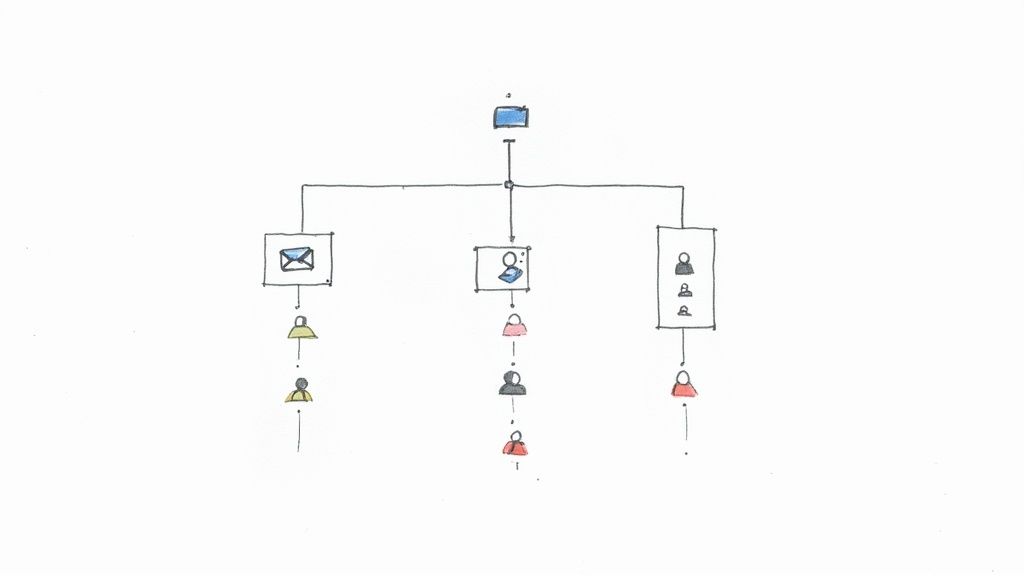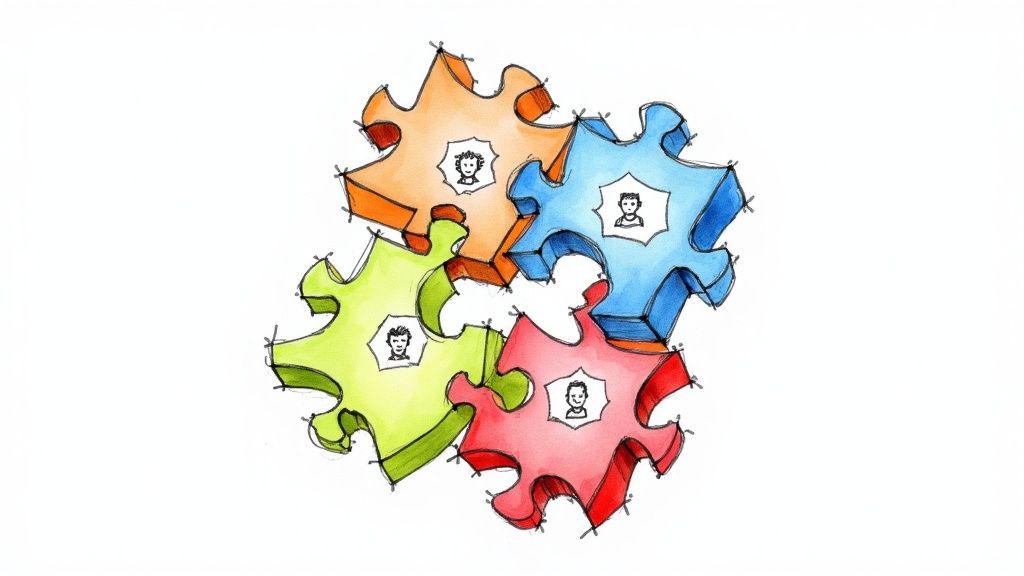September 30, 2025

In today's fast-paced, often-remote work environment, effective communication is the lifeblood of a thriving organization. It's the difference between a connected, engaged workforce and a collection of disconnected silos. Yet, many companies still rely on outdated, top-down communication methods that fail to resonate with modern teams. Generic memos and infrequent updates no longer suffice. To build a resilient, innovative, and aligned organization, you need a dynamic approach.
This article moves beyond surface-level advice to provide a deep dive into proven, actionable internal communication strategies. We'll explore strategic frameworks that foster transparency, build trust, and empower every employee to contribute their best work. Prepare to transform your internal dialogue from a simple broadcast into a strategic asset that drives real business results. For a comprehensive overview of strategies to enhance your organization's messaging and engagement, delve deeper into these proven internal communication best practices.
This guide offers a structured roadmap for community managers, corporate leaders, and event organizers aiming to elevate their internal messaging. You will learn how to:
We will unpack eight essential practices, providing specific implementation details and practical examples for each. From fostering transparent leadership communication to ensuring timely information sharing and boosting cross-departmental collaboration, these insights are designed for immediate application. Let's move beyond the traditional memo and build a communication ecosystem that truly connects and motivates your entire organization.
One of the most foundational internal communication best practices is creating a structured framework that dictates how information flows within your organization. This involves establishing clear, purpose-driven communication channels and protocols, which means defining when, how, and where different types of messages should be shared. Without this clarity, employees waste time searching for information, important updates get lost in a sea of notifications, and collaboration suffers from a lack of consistency.
A structured approach eliminates this "communication chaos." It ensures every employee knows exactly which tool to use for a specific purpose, whether it's an urgent project update, a company-wide announcement, or an informal team chat. This practice sets clear expectations for response times and participation, fostering a more efficient and less stressful work environment.

This method is effective because it brings order and intention to daily interactions. By assigning a specific role to each channel, you prevent the common problem of "channel-fatigue," where employees are overwhelmed by constant pings from multiple platforms. For instance, a project management tool is for task-specific updates, a chat app like Slack or Teams is for quick questions, and email is reserved for formal, external, or less time-sensitive communication.
Key Insight: A well-defined channel strategy transforms communication from a reactive, disorganized activity into a proactive, strategic function that supports business goals.
Companies like Slack exemplify this by using their own platform with dedicated channels for every project, team, and topic, creating a searchable, organized history of communication. Similarly, Microsoft implements Teams with a strict channel hierarchy, ensuring discussions within business units remain focused and accessible.
Getting started requires a strategic and inclusive approach. Simply adding new tools without a plan will only worsen the problem.
A core pillar of effective internal communication is a commitment from leadership to be consistently transparent and communicative. This practice involves senior leaders regularly sharing organizational information, the "why" behind key decisions, and a clear vision for the future. It’s about building a culture where open dialogue is the norm, encompassing both successes and challenges, rather than an occasional event triggered by a crisis.
This systematic approach demystifies the organization's direction and helps employees connect their daily work to broader company goals. When leaders communicate openly, they foster a deep sense of psychological safety and trust, which are essential for employee engagement, innovation, and retention. It transforms the employee-employer relationship from a transactional one into a shared partnership.

This method is powerful because it directly counters uncertainty and misinformation, which are major drivers of disengagement and anxiety in the workplace. By providing a steady stream of authentic information, leaders can manage the narrative, prevent rumors, and ensure everyone is aligned. It shows respect for employees as critical stakeholders in the business's success, making them feel valued and heard.
Key Insight: Consistent leadership transparency is not just about sharing good news; it's about building institutional trust that can withstand challenges and inspire collective effort toward a common vision.
Companies like Patagonia have long championed this, with founder Yvon Chouinard openly communicating business decisions and their environmental impact. Similarly, HubSpot maintains transparency through its famous Culture Code and regular updates on company metrics, while Basecamp’s founders often use their public blogs to discuss business philosophy and internal decisions, making this one of the most vital internal communication best practices.
Integrating this practice requires a genuine commitment from the top down and a structured plan for execution.
Effective internal communication is not a one-way broadcast; it's a dynamic dialogue. A critical best practice is to implement structured systems for active listening and two-way feedback. This means creating formal mechanisms that not only disseminate information from leadership but also actively capture, process, and respond to employee feedback, concerns, and ideas. Without this, organizations risk fostering a culture of disengagement where employees feel unheard and undervalued, leading to lower morale and innovation.
This approach transforms communication from a monologue into a conversation. It builds psychological safety, empowering employees to voice their perspectives without fear of reprisal. By systematically collecting and acting on feedback, leadership demonstrates that every voice matters, which is fundamental to building a transparent and resilient organizational culture.

This method is powerful because it directly impacts employee engagement and retention. When employees see their input leading to tangible changes, they become more invested in the company's success. It also serves as an early warning system, allowing leadership to identify and address potential issues before they escalate. Active listening and feedback loops foster a culture of continuous improvement, where processes and strategies are constantly refined based on frontline insights.
Key Insight: Shifting from top-down messaging to a two-way feedback system turns employees into active participants in the organization's evolution, driving both innovation and loyalty.
Companies like Google have perfected this with their "Googlegeist" annual survey, which leads to clear action plans across the company. Similarly, Adobe replaced traditional annual reviews with its "Check-In" system, which fosters ongoing, two-way feedback conversations between managers and employees, making feedback a continuous, developmental practice.
Successfully building a feedback-rich environment requires more than just an open-door policy. It demands a structured, intentional effort.
Learn more about how to improve your team's communication on groupos.com.
A one-size-fits-all approach to internal communication is destined to fail. One of the most critical internal communication best practices is recognizing that your organization is not a monolith but a collection of diverse audiences with unique information needs, priorities, and communication preferences. Tailoring your messages ensures that information is not just sent but received, understood, and acted upon by its intended recipients.
This practice involves customizing the content, format, and delivery channel to resonate with specific groups, such as engineers, sales teams, senior leadership, or frontline staff. A technical update for the IT department will require different language and detail than a high-level strategic announcement for executives. By segmenting your audience, you transform generic broadcasts into relevant, impactful communication that drives engagement and alignment.

Segmented communication is effective because it honors the context and perspective of the employee. When individuals feel a message is directly relevant to their role and responsibilities, they are far more likely to pay attention and retain the information. This method cuts through the noise of information overload, increasing message clarity and reducing the cognitive burden on employees who would otherwise have to filter out irrelevant details.
Key Insight: Personalizing communication demonstrates respect for employees' time and intelligence, fostering a culture where every message is perceived as valuable and worth reading.
Global companies like Unilever excel at this by adapting broad corporate messages to fit local cultural contexts, ensuring global initiatives are understood and embraced at the regional level. Similarly, Salesforce customizes its internal updates, providing deep technical documentation for its engineering teams while delivering concise, benefit-focused summaries to its sales department.
Successfully tailoring messages requires a deep understanding of your internal audiences and a flexible communication strategy.
A core component of modern internal communication best practices is the strategic implementation of technology. This means going beyond simply adopting new platforms; it involves thoughtfully choosing and integrating digital tools that enhance the speed, reach, and effectiveness of your internal messaging. The goal is to create a seamless digital ecosystem where technology facilitates clear communication and collaboration without causing digital overload or burnout.
When done correctly, technology acts as an enabler, not a barrier. It helps automate routine updates, provides accessible knowledge repositories, and connects dispersed teams in a more dynamic way. The focus should always be on using tools to augment human connection and streamline workflows, ensuring that technology serves the communication strategy, not the other way around.
This method is powerful because it addresses the realities of the modern, often hybrid, workplace. The right tools can break down silos, provide data-driven insights into communication effectiveness, and ensure every employee has access to the information they need, regardless of their location or time zone. It shifts communication from a static, top-down process to an interactive, multi-directional dialogue.
Key Insight: Technology should simplify, not complicate. An effective digital tool strategy is less about having the most tools and more about having the right integrated tools that employees actually want to use.
Companies like Spotify excel here by integrating custom tools within their primary communication platform, Slack, to support their unique collaborative culture. Similarly, Zoom leverages its own video platform for synchronous meetings while complementing it with asynchronous tools to respect employees' time and focus, proving that a balanced tech stack is crucial.
A strategic rollout is essential to avoid overwhelming employees and ensure high adoption rates. A scattered approach will only lead to confusion and underutilized subscriptions.
One of the most powerful internal communication best practices is to establish a unified voice that reflects your organization's unique culture and values. This involves ensuring consistency across all internal touchpoints, so whether an employee reads an HR policy update, a leadership announcement, or a team memo, the tone, style, and core message feel cohesive and authentic. This consistency reinforces company identity and builds trust by presenting a stable, unified front.
Without a consistent internal brand voice, messaging can feel disjointed and confusing. An overly formal email from one department followed by a casual chat message from another can create a jarring experience, leaving employees unsure of the organization's true character. A defined voice aligns every piece of communication with the company's core mission, making employees feel like part of a single, coherent entity.
This method is effective because it humanizes the organization and makes communication more predictable and relatable. A consistent voice, whether it's innovative and direct or supportive and friendly, helps manage employee expectations and strengthens their connection to the company culture. It transforms routine messages from simple information dumps into opportunities to reinforce the values and behaviors that define the organization.
Key Insight: A consistent internal voice isn't about making everyone sound the same; it's about ensuring every communication reflects the same core principles and personality, building a stronger, more unified culture.
Companies like Southwest Airlines master this by infusing their fun-loving, employee-first attitude into every internal memo and announcement, mirroring their famous external brand. Similarly, Zappos built its legendary culture with a quirky, personal, and sometimes eccentric communication style that made every employee feel like an integral part of their unique community.
Developing and maintaining a consistent voice requires clear guidelines and ongoing commitment. It’s a strategic effort that goes beyond just writing well.
In an age of information overload, one of the most critical internal communication best practices is ensuring that messages are not only sent but also timely and relevant. This practice involves creating systems that deliver the right information to the right people at the right time, effectively filtering out noise. It’s about moving from a "broadcast everything" mentality to a curated, strategic approach that respects employees' attention and cognitive load.
Without this discipline, important updates are easily buried under a mountain of irrelevant emails, notifications, and announcements. Employees become conditioned to ignore communications, assuming most of it doesn't apply to them. By prioritizing relevance and timing, organizations can re-engage their workforce, ensure critical information is absorbed, and empower teams with the knowledge they actually need to succeed in their roles.
This method is effective because it treats employee attention as a valuable and finite resource. By curating information, you build trust and signal that when the company communicates, it’s worth listening to. This increases the impact of every message, from urgent policy changes to strategic business updates, because employees haven't been desensitized by constant, low-value notifications.
Key Insight: Strategic information delivery transforms internal communication from a source of distraction into a tool for focus, alignment, and productivity.
Companies like LinkedIn apply this principle internally by using algorithmic feeds and targeted notifications to surface news and updates most relevant to an employee's role, department, and stated interests. Similarly, Tesla is known for its rapid, direct communication systems that push essential production and engineering updates to specific teams in real time, bypassing slower, traditional corporate channels to maintain operational agility.
Successfully implementing timely and relevant communication requires a deliberate framework and a commitment to understanding audience needs.
One of the most impactful internal communication best practices is to actively break down organizational silos. This involves creating structured opportunities for different departments and business units to communicate, share knowledge, and collaborate. In today's complex business environment, challenges rarely fit neatly within one team's purview, and departmental isolation leads to duplicated efforts, missed innovation, and a fragmented customer experience.
By intentionally fostering cross-departmental communication, you create a more agile and resilient organization. This practice ensures that insights from marketing inform product development, that sales feedback reaches engineering, and that finance understands the operational needs of various teams. It transforms a collection of separate functions into a single, cohesive unit working toward shared goals.
This strategy is effective because it aligns the entire organization around common objectives and cultivates a holistic perspective. When teams understand how their work impacts others, they make more informed decisions and are more likely to proactively support one another. It prevents the "us vs. them" mentality that can poison a company culture and stifle progress.
Key Insight: Breaking down silos isn't just about being collaborative; it's a strategic imperative that unlocks collective intelligence, accelerates problem-solving, and drives sustainable growth.
Companies like Amazon operationalize this with their "Working Backwards" process, where new initiatives require comprehensive documents that gather input and secure alignment from all relevant teams before development begins. Similarly, Toyota’s famous Quality Circles bring together employees from different parts of the production line to solve problems collaboratively, fostering a culture of shared ownership and continuous improvement.
Implementing this practice requires deliberate systems and cultural reinforcement, not just occasional meetings.
Navigating the complexities of modern organizational life requires more than just sending emails or posting updates. As we've explored, mastering internal communication is about architecting a living, breathing ecosystem that nurtures connection, clarity, and collaboration. The journey from a disjointed messaging strategy to a high-functioning communication engine is built on the deliberate and consistent application of the internal communication best practices discussed throughout this guide. This is not a one-time project with a clear finish line; it is an ongoing commitment to building a sustainable system that gains momentum over time, much like a flywheel.
The eight pillars we've detailed, from establishing clear channels to fostering cross-departmental synergy, are not isolated tactics to be cherry-picked. Instead, they are interconnected gears. Transparent leadership communication loses its impact without effective two-way feedback channels. Tailored messaging falls flat if delivered through outdated or inaccessible technology. A consistent brand voice feels hollow if information isn't timely or relevant. True success lies in understanding how these elements work in concert, each one strengthening the others.
Let's distill the essential takeaways into a clear, actionable framework. Your primary goal is to shift your organization's mindset from broadcasting information to cultivating conversation and understanding. This requires a fundamental change in approach, prioritizing dialogue over monologue and empathy over expediency.
Moving from theory to practice can feel daunting, but you can start today by taking small, deliberate steps. Begin with an audit of your current systems. Where are the biggest friction points? Are employees unclear on where to find information? Is leadership feedback a one-way street?
Choose one or two of the best practices that address your most pressing challenges and commit to improving them. For example, you could start by standardizing your communication channels (Practice #1) and simultaneously launching a simple, regular survey to create a new feedback loop (Practice #3). As you make progress, the positive effects will create momentum, making it easier to tackle the next set of improvements. This iterative approach is the key to building your communication flywheel, where each successful initiative makes the next one easier and more impactful.
Ultimately, investing in internal communication best practices is an investment in your organization's most valuable asset: its people. When employees feel informed, heard, and connected, they are more engaged, more innovative, and more committed to shared goals. You are not just improving processes; you are building a resilient, adaptive, and thriving organizational culture.
Ready to replace your fragmented communication tools with a single, powerful platform? GroupOS provides an all-in-one solution designed to implement these best practices, integrating messaging, content delivery, and community management to drive engagement and collaboration. Discover how you can build a more connected organization at GroupOS.


